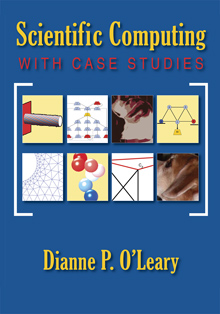
Nineteen case studies allow readers to become familiar with mathematical modeling and algorithm design, motivated by problems in physics, engineering, epidemiology, chemistry, and biology.
 |
|---|
|
Learning through doing is the foundation of this book,
which allows readers to explore case studies as well
as expository material. The book provides a practical
guide to the numerical solution of linear and nonlinear
equations, differential equations, optimization problems,
and eigenvalue problems. It treats standard problems and
introduces important variants such as sparse systems,
differential-algebraic equations, constrained optimization,
Monte Carlo simulations, and parametric studies. Stability
and error analysis is emphasized, and the
MATLAB
algorithms are grounded in sound principles of software
design and in the understanding of machine arithmetic and
memory management.
Nineteen case studies allow readers to become familiar with mathematical modeling and algorithm design, motivated by problems in physics, engineering, epidemiology, chemistry, and biology. |
Course instructors: If this is a textbook for your course, contact Elizabeth Greenspan (greenspan at siam.org) to arrange for a 20% discount for your students (30% if your institution is an institutional member of SIAM).
This website contains supplementary material for the book.
Some of the partial solutions are revisions of articles originally printed in ``Computing in Science and Engineering," Copyright IEEE. These are posted here with permission of the IEEE. Internal or personal use of this material is permitted. However, permission to reprint/republish this material for advertising or promotional purposes or for creating new collective works for resale or redistribution must be obtained from the IEEE by writing to pubs-permissions@ieee.org.